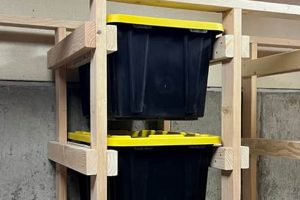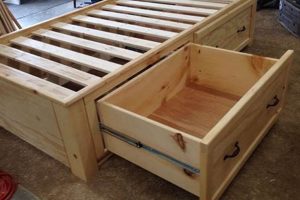Creating customized organizational systems for wood materials within a personal workshop or construction space defines a specific approach to material management. This involves constructing shelving, racks, or other structures designed to efficiently store and protect lumber and other wooden stock. A common example is building a wall-mounted rack using readily available hardware to keep dimensional lumber off the floor and readily accessible.
Effective material organization yields numerous advantages, including maximizing available workspace, preventing damage to valuable wood resources, and streamlining project workflows. Historically, efficient resource management has been critical for minimizing waste and optimizing productivity in both professional and amateur woodworking endeavors. The ability to readily access and protect materials contributes directly to project success and cost savings.
The subsequent sections detail specific construction techniques, material selection considerations, and spatial optimization strategies applicable to building personalized systems. These guidelines aim to provide a foundation for constructing a solution tailored to individual needs and resource constraints.
Tips for Optimized Lumber Organization
The following tips provide guidance for maximizing the efficiency and effectiveness of wood storage solutions. Implementing these strategies can enhance workspace organization, prolong material lifespan, and improve project workflow.
Tip 1: Utilize Vertical Space: Maximize storage capacity by constructing vertical shelving or racks. Wall-mounted systems effectively utilize otherwise unused space, freeing up valuable floor area.
Tip 2: Categorize Lumber by Type and Size: Designate specific areas for different species and dimensions of wood. This facilitates quick identification and retrieval of desired materials.
Tip 3: Implement a First-In, First-Out (FIFO) System: Arrange lumber so that older stock is used first. This minimizes the risk of warping, cracking, or insect infestation due to prolonged storage.
Tip 4: Protect Lumber from Moisture: Store wood in a dry, well-ventilated area to prevent moisture absorption. Consider using a dehumidifier in damp environments.
Tip 5: Support Lumber Properly: Ensure lumber is adequately supported to prevent sagging or bending. Use evenly spaced supports when storing long pieces horizontally.
Tip 6: Label Storage Areas Clearly: Affix labels to shelves or racks indicating the contents. This reduces search time and minimizes the risk of misidentification.
Tip 7: Consider Mobile Storage Options: For workshops with limited space, mobile carts or racks can provide flexible storage solutions that can be easily moved as needed.
Implementing these tips will contribute to a more organized, efficient, and ultimately more productive workspace. Proper lumber storage is an investment that pays dividends in terms of reduced material waste and streamlined workflow.
The following section will address common challenges encountered when designing and constructing custom lumber storage solutions.
1. Space Optimization
Space optimization, within the context of constructing personalized storage solutions for lumber, represents a critical factor in workshop efficiency and material management. It is the process of maximizing the utility of available square footage to accommodate lumber of varying dimensions and quantities.
- Vertical Storage Solutions
Implementing vertical storage systems, such as wall-mounted racks or floor-to-ceiling shelving, maximizes the use of vertical space. This minimizes the footprint of lumber storage, freeing up valuable floor area for work activities and equipment placement. For instance, a tiered rack system can accommodate a wide variety of lumber lengths and thicknesses while occupying a minimal amount of floor space.
- Mobile Storage Carts
Mobile carts equipped with storage compartments or racks offer flexible storage solutions, particularly in workshops with limited space. These carts can be easily relocated to different areas of the workshop as needed, allowing for dynamic rearrangement of the workspace to accommodate specific project requirements. This is exemplified by a lumber cart on casters that can be moved near a workstation for easy access to materials.
- Utilizing Overhead Space
In workshops with high ceilings, utilizing overhead space for lumber storage presents another space-saving strategy. Suspended racks or platforms can be constructed to store longer pieces of lumber, keeping them out of the way while preserving valuable floor space. An example would be a platform suspended from the ceiling joists, designed to store dimensional lumber in a horizontal orientation.
- Optimizing Shelf Depth and Spacing
Carefully planning shelf depth and spacing is crucial for maximizing storage capacity within a given area. Adjustable shelving allows for customization to accommodate lumber of varying thicknesses, minimizing wasted space. This is demonstrated by a shelving unit with adjustable shelf heights that can be configured to precisely fit the dimensions of the lumber being stored.
The successful integration of these space optimization strategies directly impacts workflow efficiency and safety within the workshop. By maximizing storage capacity and minimizing clutter, the workshop environment becomes more conducive to productivity and reduces the risk of accidents associated with disorganized materials. The conscious allocation of lumber contributes to overall optimization.
2. Material Selection
Material selection exerts a direct influence on the efficacy and longevity of personalized wood storage systems. The choice of construction materials dictates the systems load-bearing capacity, resistance to environmental factors, and overall structural integrity. For instance, pressure-treated lumber is preferable for outdoor storage structures due to its enhanced resistance to decay and insect infestation, while steel provides superior load-bearing capabilities for heavy timber storage.
The improper selection of materials can lead to structural failure, resulting in potential damage to the stored lumber and posing safety hazards. A system constructed from softwood without adequate reinforcement may buckle under the weight of heavier hardwoods. Conversely, the use of excessively robust materials, such as thick-gauge steel, where lighter materials would suffice, leads to unnecessary cost and increased construction complexity. An example is a basic wall-mounted rack designed for storing lightweight trim; constructing such a rack from heavy steel tubing would be overkill.
Therefore, a comprehensive understanding of material properties and the specific requirements of the storage system is paramount. Considerations must include the anticipated weight of the stored lumber, environmental conditions, and available budget. Balancing these factors ensures the construction of a durable, cost-effective, and safe storage solution tailored to individual needs. Failure to do so compromises the system’s ability to function as intended, potentially leading to material damage and safety risks.
3. Load Capacity
Load capacity is a fundamental consideration in the design and construction of personalized lumber storage systems. It dictates the system’s ability to safely and effectively support the weight of the stored materials. Inadequate attention to load capacity can result in structural failure, damage to the stored lumber, and potential injury.
- Material Strength and Span
The load-bearing capacity of a lumber storage system is directly related to the strength of the materials used and the span between supports. Materials with higher tensile and compressive strength, such as steel or hardwood, can support greater loads over longer spans than weaker materials, like softwood. The span between supports affects the bending moment and shear stress experienced by the structural members; shorter spans increase the load capacity. For example, a shelf made of 2×4 pine spanning four feet will support significantly less weight than the same shelf made of 2×4 steel.
- Fastener Selection and Placement
The type and placement of fasteners are crucial for distributing load and preventing joint failure. Screws, bolts, and nails must be appropriately sized and spaced to withstand the forces exerted by the weight of the lumber. Insufficient fastener density or the use of inappropriate fasteners can lead to joint separation or fastener shear. For instance, using drywall screws in a joint intended to bear a heavy load would be a critical error, as drywall screws are brittle and prone to snapping under stress.
- Structural Design Considerations
The overall design of the lumber storage system significantly influences its load capacity. Factors such as bracing, triangulation, and the distribution of weight across multiple supports contribute to structural stability. Properly designed bracing, such as diagonal supports, prevents racking and twisting, increasing the system’s ability to withstand lateral loads. Even weight distribution minimizes stress concentrations and reduces the risk of localized failure. An example is a properly braced A-frame lumber rack, which is far more resistant to collapse than a simple unbraced vertical rack.
- Weight Distribution and Safety Factors
Accurate estimation of the maximum anticipated load is essential for determining the appropriate safety factor. This factor accounts for variations in material strength, construction quality, and unexpected overloads. It is prudent to design the system with a safety factor of at least 2, meaning that the system should be able to withstand twice the anticipated maximum load. In addition, uneven weight distribution can create stress concentrations, potentially leading to failure even if the overall load is within the system’s rated capacity. Therefore, lumber should be stacked evenly and supported uniformly to minimize the risk of overloading any single point.
These facets underscore the integral role of load capacity in the design and construction of storage solutions. The material choices must coincide with anticipated forces. Understanding and calculating the lumber’s load capacity enables a durable and reliable storage system. Thoughtful engineering provides safety, efficiency, and economy.
4. Accessibility
Accessibility, within the context of creating personalized wood storage, directly influences workflow efficiency and project success. The ease with which lumber can be retrieved and returned to storage significantly impacts the time required to complete woodworking projects. A poorly designed storage system that necessitates excessive maneuvering or disassembly to access specific pieces increases the likelihood of project delays and frustration. Conversely, an optimized system facilitates rapid retrieval, enabling a smoother and more productive workflow. For example, consider a cabinet maker requiring a specific type of hardwood for a drawer front. If that hardwood is buried behind other materials in a disorganized pile, the time spent locating and extracting it adds unnecessary overhead to the project. This delay translates into increased labor costs and reduced overall productivity.
Several design features contribute to improved accessibility. Vertical storage systems, such as wall-mounted racks or open shelving, allow for visual identification and immediate access to individual pieces. The use of labeled compartments or color-coding further streamlines the retrieval process. Strategically positioning the storage system near the primary work area minimizes travel distance, reducing the time spent transporting materials. Moreover, implementing a “first-in, first-out” (FIFO) storage system, where older stock is placed at the front of the storage array, ensures that lumber is used in a timely manner and prevents it from becoming buried and inaccessible. A real-world example of this is a rolling lumber rack where each level is dedicated to specific wood types, labeled clearly and arranged to facilitate the easy removal of the desired piece without disturbing the others.
In summary, accessibility is an indispensable component of effective lumber storage. The deliberate integration of design features that promote efficient retrieval and storage translates into tangible benefits, including reduced project completion times, minimized material waste, and enhanced overall workshop productivity. Addressing the challenges of accessibility ensures a smoother workflow. As such, when designing lumber storage solutions, consider the retrieval processes’ ergonomics.
5. Protection
Safeguarding lumber from environmental factors and physical damage constitutes a critical aspect of personalized wood storage. The longevity and usability of lumber are directly correlated with the effectiveness of protective measures implemented during storage.
- Moisture Control
Excessive moisture exposure leads to warping, fungal growth, and dimensional instability in lumber. Implementing moisture control strategies, such as storing lumber in a well-ventilated environment or using dehumidifiers, mitigates these risks. For example, constructing a lumber rack within a climate-controlled workshop protects lumber from humidity fluctuations prevalent in unconditioned spaces. Conversely, storing lumber directly on a concrete floor without a vapor barrier allows moisture to wick into the wood, leading to degradation.
- Pest Prevention
Wood-boring insects, such as termites and carpenter ants, can inflict significant damage on stored lumber. Preventative measures include applying insecticide treatments, using insect screens to enclose storage areas, and regularly inspecting lumber for signs of infestation. As an illustration, storing lumber off the ground on a metal rack minimizes contact with soil-dwelling pests. In contrast, stacking lumber directly against a wooden fence provides a pathway for insect infestation.
- UV Radiation Mitigation
Prolonged exposure to ultraviolet (UV) radiation causes discoloration, surface checking, and embrittlement in lumber. Protecting lumber from direct sunlight by storing it indoors or covering it with opaque tarpaulins reduces UV damage. For instance, storing lumber under a carport or in a shed shields it from the sun’s harmful rays. Conversely, leaving lumber uncovered in an open area exposes it to UV radiation, accelerating its degradation.
- Physical Damage Prevention
Physical damage, such as scratches, dents, and abrasion, compromises the aesthetic value and structural integrity of lumber. Implementing measures to prevent physical damage includes padding storage racks, using protective covers, and handling lumber with care. As an example, lining lumber rack supports with felt or foam protects the lumber from scratches. In contrast, carelessly stacking lumber on top of sharp or abrasive objects increases the risk of surface damage.
The successful integration of protection strategies safeguards against loss, reduces expenditure, and maintains the quality of wood. Proper protection contributes to workflow efficiency and project outcomes. Consequently, these considerations require an appropriate assessment of lumber and protection goals.
6. Cost Efficiency
The integration of cost efficiency within the realm of self-constructed lumber storage systems represents a critical element affecting both the initial investment and the long-term operational expenditures of woodworking endeavors. Economical design and material selection directly influence the affordability of creating a personalized storage solution, while effective organization and protection minimize waste and extend the lifespan of stored lumber. The repercussions of neglecting cost considerations can range from overspending on unnecessary features to incurring recurring expenses due to material degradation and inefficient workflow. A clear illustration involves comparing the cost of building a rack from reclaimed lumber versus purchasing a prefabricated steel unit. While the former requires more labor, the initial material cost is significantly lower. Conversely, the steel unit, though more expensive upfront, offers superior durability and load capacity, potentially offsetting its higher initial cost over time.
Further analysis reveals that optimizing space utilization and minimizing material waste are central to cost-efficient lumber storage. By employing vertical storage strategies, available space is maximized, reducing the need for expansive and costly storage areas. Similarly, carefully planning cuts and minimizing scrap during the construction of the storage system reduces material costs and environmental impact. Examples include utilizing leftover lumber from other projects or adapting existing shelving units for lumber storage. Furthermore, proper lumber protection, such as moisture control and pest prevention, minimizes material degradation, preventing premature replacement and associated costs. Storing lumber off the ground on a simple, self-built rack significantly reduces the risk of moisture damage, thereby extending the usable lifespan of the stored materials. Implementing these strategies reduces expenditure from replacing the lumber and adds value.
In conclusion, a holistic approach to cost efficiency is essential for maximizing the value and minimizing the financial burden associated with personalized lumber storage. Strategic material selection, space optimization, and material protection contribute to a more sustainable and economical woodworking practice. The challenge lies in balancing the initial investment with the long-term benefits, ensuring that the chosen solution is both affordable and effective in preserving valuable wood resources. Recognition of cost-efficient benefits proves a cost-effective strategy and a durable storage system.
7. Durability
The longevity of a self-constructed lumber storage system directly correlates with its durability. Durability, defined as the capacity to withstand wear, pressure, or damage, is paramount to the sustained functionality and safety of such systems. The materials selected, the construction techniques employed, and the environmental conditions to which the system is exposed all influence its overall lifespan. A system constructed from inferior materials or employing inadequate construction methods will inevitably fail prematurely, necessitating costly repairs or complete replacement. For instance, a lumber rack fabricated from untreated softwood and assembled with insufficient fasteners will likely warp, sag, or collapse under the weight of heavy lumber, rendering it unusable and potentially hazardous. Conversely, a system engineered with durable materials and robust construction techniques will provide years of reliable service, protecting valuable lumber resources and ensuring a safe working environment.
The practical significance of understanding the relationship between durability and lumber storage lies in the ability to make informed decisions regarding design and construction. Selecting weather-resistant materials, such as treated lumber or steel, is critical for systems exposed to outdoor elements. Similarly, employing joinery techniques that enhance structural integrity, such as mortise and tenon joints or reinforced metal connections, increases the system’s resistance to stress and strain. Furthermore, implementing protective measures, such as applying weather sealant or rust-inhibiting coatings, can significantly extend the lifespan of the system. Consider a scenario where a woodworker builds a lumber rack from pressure-treated lumber, using bolted connections and reinforcing brackets. This system, designed with durability in mind, will withstand exposure to moisture, temperature fluctuations, and heavy loads, ensuring its continued functionality for many years. In contrast, a rack built without these considerations will quickly deteriorate, requiring frequent repairs or replacement.
In conclusion, durability is an indispensable component of a successful self-constructed lumber storage system. Understanding the factors that contribute to or detract from durability allows for the creation of systems that are both cost-effective and reliable. While initial cost may be a consideration, investing in durable materials and sound construction techniques ultimately provides greater long-term value by minimizing maintenance, preventing material damage, and ensuring a safe and productive woodworking environment. The challenge lies in striking a balance between affordability and longevity, selecting materials and methods that provide the best possible durability within a given budget. This mindful consideration of durability contributes to a storage system that preserves and protects.
DIY Lumber Storage
This section addresses common inquiries regarding the design, construction, and maintenance of personalized lumber storage systems. The aim is to provide clear and concise answers to assist in creating effective and durable storage solutions.
Question 1: What factors determine the appropriate load capacity for a lumber storage rack?
The load capacity is determined by the type of materials used (wood, steel, etc.), the span between supports, and the method of joinery. The design should incorporate a safety factor to accommodate potential overloads or material variations.
Question 2: How can moisture damage be prevented in lumber storage?
Moisture damage is mitigated by storing lumber in a well-ventilated area, elevating lumber off the ground, and, if necessary, using a dehumidifier to control humidity levels.
Question 3: What are the advantages of vertical lumber storage compared to horizontal storage?
Vertical storage maximizes floor space, facilitates easier access to individual pieces, and reduces the risk of warping compared to horizontal stacking over long spans.
Question 4: How can lumber be protected from insect infestation during storage?
Insect infestation is prevented by storing lumber off the ground, inspecting lumber regularly for signs of pests, and applying appropriate insecticide treatments or repellents.
Question 5: What materials are best suited for constructing a durable lumber storage system?
Durable materials include pressure-treated lumber for outdoor use, steel for high-load applications, and hardwoods for enhanced strength and resistance to wear.
Question 6: How can accessibility be improved in a lumber storage system?
Accessibility is enhanced by implementing clear labeling, organizing lumber by type and size, utilizing a first-in, first-out (FIFO) system, and ensuring sufficient clearance around storage areas.
Effective lumber storage solutions require careful consideration of load capacity, moisture control, storage orientation, pest prevention, material selection, and accessibility. Addressing these factors ensures the longevity and usability of stored lumber.
The next section will explore specific design considerations for creating various types of personalized lumber storage systems.
DIY Lumber Storage
This examination has traversed critical facets pertinent to crafting personalized wood material repositories. Factors encompassing spatial efficiency, material fortitude, weight-bearing capability, retrieval ease, preservation protocols, fiscal prudence, and structural resilience have been delineated. Attentiveness to these elements ensures the establishment of a secure, efficient, and cost-effective environment for preserving wood resources.
Implementing these principles allows individuals to maximize resources, minimize waste, and enhance workplace safety. The adoption of considered practices translates directly into tangible benefits: reduced material expenses, heightened project efficiency, and a more sustainable approach to woodworking. Diligent application of these guidelines will empower individuals to protect valuable resources, optimize their workflow, and foster lasting efficiency in their workshop endeavors.







